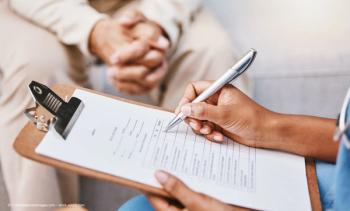
- Ophthalmology Times Europe March/April 2025
- Volume 21
- Issue 2
- Pages: 24 - 26
New trends in the diagnosis of dry eye disease: A patient-centric approach
A five-step approach to personalise and simplify treatment, leading to higher efficacy
The impact of dry eye disease (DED) on patients’ quality of life and the discordance between signs and symptoms are well documented. We also know there is often considerable delay between patients experiencing symptoms and seeking a definitive diagnosis.1 Once patients do present with DED, it is essential to utilise a simplified, patient-centred diagnostic approach that is practical, effective and objective. The following approach was developed from many years of clinical experience and published research, and it aligns with the Tear Film & Ocular Surface Society and the American Academy of Ophthalmology guidelines. It is designed to be applicable across a wide range of clinical settings, ensuring quick, accurate and personalised diagnoses for patients with DED.
A systematic, simplified approach to diagnosis
Although DED is a complex and multifactorial disease, a streamlined method was developed that takes no more than 5 to 10 minutes in everyday practice. At its core, this process is designed to evaluate symptoms and signs simultaneously, allowing for a comprehensive understanding of the condition. Symptoms reflect the patient’s perceived disease severity, while signs provide an objective measure for clinicians to assess. Together, these elements form the foundation for a tailored treatment plan that improves quality of life and prevents disease progression.
Step 1: Assess signs and symptoms
Interestingly, patients from diverse linguistic and cultural backgrounds often use similar words to describe their dry eye symptoms. This makes the initial diagnosis straightforward for any clinician who is aware of the standard expressions used by patients with symptomatic DED. The key lies in listening carefully to the patient’s account and identifying symptoms and patterns that are indicative of DED. Symptoms can be significantly influenced by comorbidities, which often amplify the severity as perceived by the patient.
Step 2: Assess the global burden of dry eye
To better understand the disease’s impact on daily life, tools like the Pentascore questionnaire are recommended (Figure 1), which evaluates the intensity and frequency of ocular discomfort, the effect of DED on daily activities (e.g., reading, screen time or exposure to air conditioning) and the efficacy and tolerability of ongoing treatments.2
Data from a recent study conducted across five European countries revealed that nearly 40% of patients feel the need to wear sunglasses regardless of the weather, 31% avoid air conditioning and 25% describe difficulty using video screens due to their disease.3 This holistic assessment helps clinicians quantify the burden of DED beyond just ocular symptoms, ensuring that the disease’s broader impact on the patient’s life is considered (Figure 2).
Step 3: Establish the type of dry eye disease
Clinicians should also note symptoms to distinguish between evaporative and aqueous-deficient forms of DED, ensuring targeted interventions. While 80% to 90% of DED cases are (at least partially) evaporative, and despite the consistency of a short tear break-up time (TBUT) in all cases of DED, a short TBUT is not synonymous with DED.
Other conditions can also result in a short TBUT, including toxicity from eye drops, past corneal infections, eyelid malposition, floppy eyelid syndrome, Demodex infestation, Thygeson superficial punctate keratitis, map-dot-fingerprint dystrophy, and even neuropathic corneal pain syndrome. Distinguishing the differential diagnosis is critical in developing a treatment plan tailored to the patient’s condition.
Step 4: Perform patient exam and additional testing
The next step of the diagnostic method is the clinical examination, which includes a detailed assessment of the ocular surface, including the conjunctiva, cornea and eyelids. Dye staining is also recommended to evaluate tear quality, and the Schirmer test should be performed at least once when taking charge of a new patient. Notably, 95% of patients do not require elaborate ancillary testing with sophisticated machines. This minimalist approach helps streamline the diagnostic process, ensuring it remains efficient and accessible for all clinicians.
Step 5: Tailor treatment based on findings
Once the diagnosis is confirmed, the focus shifts to tailored treatment plans. Identifying and removing causal agents, such as non-adapted medications or environmental factors, is essential wherever possible. For patients with associated systemic diseases such as Sjögren syndrome, the clinician should collaborate with colleagues from internal medicine specialties.
Topical treatment of DED often includes tear substitutes, with the type of polymers being adapted to the subtype and severity of the DED. Tear substitutes can also contain osmoprotectants, antioxidants, lipids or other active components targeting the presumed key factors for a given patient. Inflammatory forms of DED may require additional anti-inflammatory therapies.
Conclusion: Simplified diagnosis, effective treatment
In summary, a patient-centric, streamlined approach to diagnosing DED is precise and efficient, allowing clinicians to develop personalised treatment plans that significantly enhance the patient’s quality of life. Considering the symptoms and signs of DED and addressing the underlying comorbidities that influence the disease’s severity is an approach that underscores the importance of semiology in understanding DED. It also highlights that diagnosing and treating dry eye can be accomplished in 5 to 10 minutes, making this model accessible to all eye care professionals.
References
1. Kandel H, Stapleton F, Downie LE, et al. Impact of dry eye disease on patient-reported quality of life: a Save Sight Dry Eye Registry study. Ocul Surf. 2025;37:11-23. doi:10.1016/j.jtos.2025.02.005
2. Labetoulle M, Benichou J, M’nafek N, et al. Assessment of patient burden from dry eye disease using a combination of five visual analogue scales and a radar graph: a pilot study of the PENTASCORE. Br J Ophthalmol. 2022;106(4):467-473.
doi: 10.1136/bjophthalmol-2020-317473
3. Labetoulle M, Rolando M, Baudouin C, van Setten G. Patients’ perception of DED and its relation with time to diagnosis and quality of life: an international and multilingual survey. Br J Ophthalmol. 2017;101(8):1100-1105. doi:10.1136/bjophthalmol-2016-309193
Marc Labetoulle, MD, PhD | E: [email protected]
Labetoulle is the chair and professor of ophthalmology at Paris-Saclay University and professor at Quinze-Vingts National Vision Hospital, both in Paris, and head of the ophthalmology department at Bicêtre Hospital, Le Kremlin-Bicêtre, France.
Articles in this issue
9 months ago
Rethinking race as a risk factor for glaucomaNewsletter
Get the essential updates shaping the future of pharma manufacturing and compliance—subscribe today to Pharmaceutical Technology and never miss a breakthrough.




